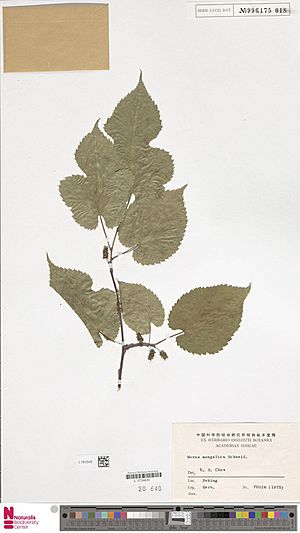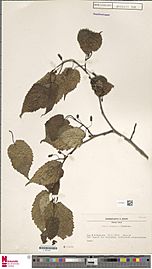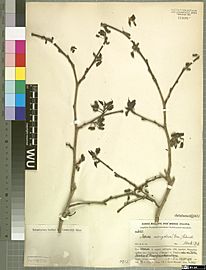Mongolian mulberry facts for kids
Quick facts for kids Mongolian mulberry |
|
|---|---|
 |
|
| Scientific classification | |
| Synonyms | |
|
Morus alba var. mongolica Bureau |
Morus mongolica, also known as the Mongolian mulberry, is a special kind of tree. It grows naturally in the mountain forests of Mongolia, China, Korea, and Japan. People in Mongolia sometimes call it ilama. Unlike some mulberries, the Mongolian mulberry grows wild and is not usually farmed by people.
Contents
About the Mongolian Mulberry
The Mongolian mulberry is a tree that can live for many years. It can grow up to about 8 meters (26 feet) tall. Its leaves look like a hand with fingers spread out (this is called "palmate"). These leaves are usually about 8 to 15 centimeters (3 to 6 inches) long and 5 to 8 centimeters (2 to 3 inches) wide.
Flowers and Fruits
This tree has different flowers for males and females, which grow in groups called inflorescences. Male flower groups are about 3 to 4 centimeters long. Female flower groups are about 2 centimeters long. Both types of flower groups have a small stem called a peduncle.
Each flower has four sepals (small leaf-like parts that protect the bud) and four petals. Male flowers have four stamens (which make pollen). Female flowers have four carpels (which contain the seeds). The tree's flowers bloom from March to April. Its fruits appear from April to May.
The fruits grow in clusters and are dull red to black when ripe. Each fruit cluster is about 1 to 3 centimeters long. The tiny individual parts of the fruit are called drupelets, and they are about 3 millimeters wide.
Where it Grows
The Mongolian mulberry naturally grows in the mountains. You can find it in Mongolia, China, Korea, and Japan.
How it Helps Nature
The leaves of the Mongolian mulberry are an important food source for silkworms. Silkworms eat these leaves. They use the nutrients from the leaves to make the cocoons that produce silk.
Uses of the Tree
The fruits of the Mongolian mulberry have been eaten by Mongol herdsmen for a long time. The wood from this tree might also be useful. Some people think it could be used as a source of biofuel, which is a type of energy made from plants.





